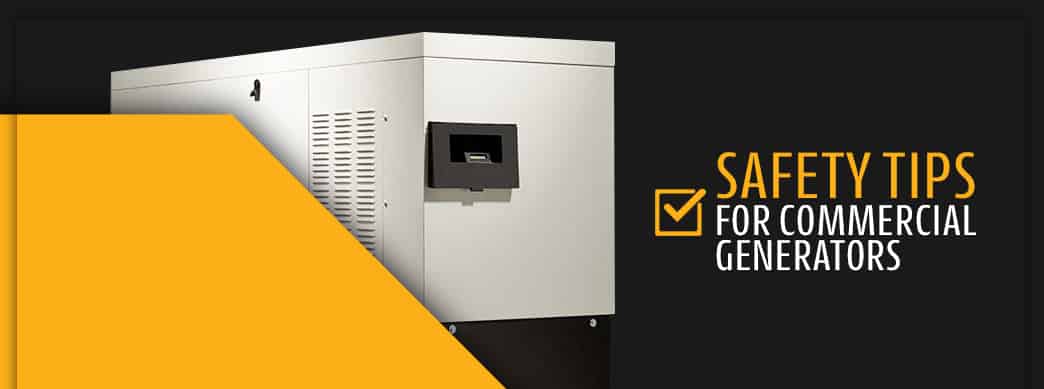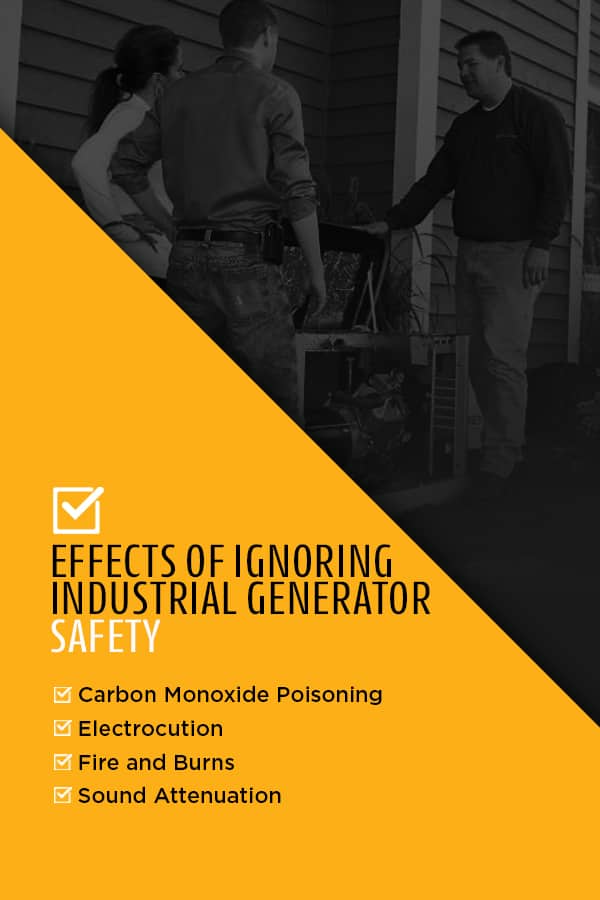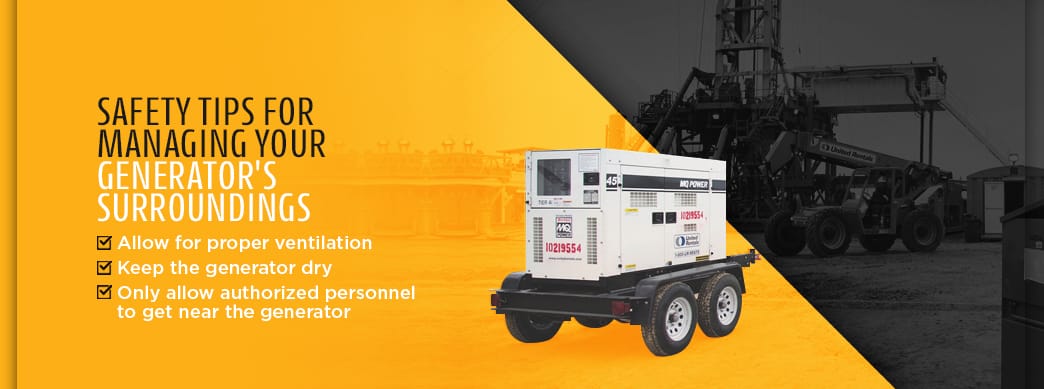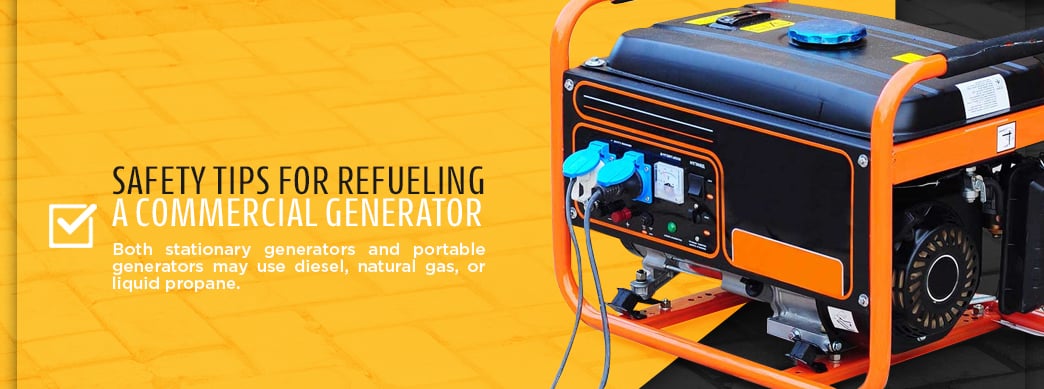Safety Tips for Commercial Generators

Backup generators are an important part of a business. They serve as a major defense against power outages in the event of a storm, accident or other cause of a power failure, such as natural disasters, man-made disasters, or the aging power grid. With a generator to keep things up and running, businesses have the power supply they need to run 24/7.
Generators are also potentially dangerous pieces of equipment. It’s critical to take safety precautions whenever you maintain or operate a generator. Improper use and handling of a generator can change result in generators becoming a game-changer in the event of power outages to a dangerous piece of heavy machinery.
We’ll share essential safety tips for industrial generators to help you keep your business, employees and customers safe.
Effects of Ignoring Industrial Generator Safety
If a generator is not properly installed, maintained or handled, it can cause a fire, damage electrical equipment or give off deadly levels of carbon monoxide (CO). For example, in 2017, there were 67 deaths involved with portable generators due to CO emissions. Here are the top reasons to practice generator safety.

1. Carbon Monoxide Poisoning
CO is an odorless, colorless gas. Because it gives no warning with taste or smell, it’s referred to as the “silent killer.” Workers may not know they are being exposed to dangerous CO levels. For example, according to an Occupational Safety and Health Administration (OSHA) news release from 2013, a worker was found in a New England warehouse unconscious, suffering from CO poisoning. Other workers at the site also became sick. The windows and doors had all been shut to conserve heat, and there was no exhaust ventilation in the facility. They found very high levels of carbon monoxide, which could have been prevented had they ventilated the area.
A person exposed to dangerous CO levels may experience symptoms associated with the early stage of CO poisoning. Common CO poisoning symptoms include:
- Headache
- Dizziness
- Weakness
- Confusion
- Vomiting
- Chest pain
Breathing in too much CO makes someone pass out or die in a matter of minutes.
All fuel-burning equipment emits some level of carbon monoxide. Whenever you burn gasoline, diesel or propane, whether it be in a car, forklift or commercial generator, you produce CO fumes. By not running a generator in a well-ventilated area, not having a properly ventilated generator room, or by running it improperly, you run the risk of CO poisoning.
2. Electrocution
Generators are often paired together with an Automatic Transfer Switch (ATS). An ATS will prompt the generator to kick in seconds within the event of power loss due to power outage. Once power is restored from the main power grid, the generator will be prompted to shut off, as service from the main grid will resume. This is simply due to the fact that because the ATS is connected to the main grid, the ATS can detect an outage and signal the control panel to start the generator without the need to manually start the generator.
Without an ATS (Automatic Transfer Switch), you will need staff on-site to manually flip the switch on the generator controls to run the generator in the event of a power outage and must also manually turn off the generator once power is restored. Failure to turn off the generator after power to the main grid is restored can cause an effect called back feeding, which can be lethal to any electricians or maintenance workers that are working on the power lines.
3. Fire and Burns
If you exceed the generator’s power rating, you could overload the generator. This could damage the generator as well as appliances hooked up to the generator. The generator could also overheat and catch on fire. It’s crucial to know what your generator can handle or to buy a generator that meets your power needs. When dealing with commercial generators, the first step is to calculate power needs and requirements to avoid overloading your generator and ensure that your generator is properly sized to provide adequate power.
Business owners also need to keep themselves and their employees safe from generator-related burns. Generators get hot when they run, and they remain hot for a long time once they are shut down. General workers should know not to touch generators.
4. Sound Attenuation
Commercial generators are loud. Simply stated, these generators not only produce high outputs of power, but can also generate noise at high frequencies. The high frequencies result in noise that reaches high-decibel levels that can seriously damage or rupture eardrums, or worse, can permanently deafen those that near the generator.
In order to protect you and your employees, ensure that they wear earmuffs at all times when working with or near a generator. Businesses that have a dedicated generator room will need to be sure that the generator room is located away from employees. Not only is generator room ventilation vital, but ensuring the generator is inaudible to employees is a necessity to protect their overall well-being.
If the generator has an enclosure, make sure that the generator is properly sound-attenuated. Sound-attenuated enclosures help reduce noise and decibel levels of a commercial generator, which will help protect your employees that are working with/around the generator itself.

Safety Tips for Managing Your Generator’s Surroundings
You can control the environment around your commercial generator and install it in a safe place. If you’re installing a new generator, we recommend contacting an expert to help you determine the best site. Here are some safety tips to keep in mind:
- Allow for proper ventilation: All businesses, large or small, should only operate generators outdoors to allow for proper ventilation. If you use a portable generator, plan to operate it outside. Large commercial standby generators must be located outside of the building and secured on a concrete slab or properly installed in a dedicated generator room with proper ventilation. In either case, do not install generators near windows, vents or air intakes which could allow CO to get circulated inside. Make sure generators have at least 3 to 4 feet of clear space on all sides and are placed at least 15 feet from open windows. Install CO detectors in the building and test them regularly.
- Keep the generator dry: Pad placement is the most critical element in protecting your generator from flooding. If you’re about to install or move a generator, survey the area and choose the highest ground possible. Also, make sure the area is level to prevent standing water from pooling around the unit. Rental or portable generators should be removed from the soft ground at construction sites and placed on high, level ground. Carefully read the manufacturer’s instructions on adequately grounding the generator. If using a portable generator, place it under a canopy structure to keep it dry.
- Only allow authorized personnel to get near the generator: A generator can get hot while operating, and could cause burns. Plan to include safety barriers such as fences, bars or posts to ensure general employees and visitors cannot access the generator.
Safety Tips for Moving an Industrial Generator
Moving a commercial generator is an involved process which requires careful planning. Portable generators can easily be moved, but commercial generators are anchored to a concrete slab. Here are tips to help you move an industrial generator as safely and efficiently as possible:
- Contact an industrial rigger: Commercial generators are very large and heavy. An industrial rigger is trained to safely lift and move heavy commercial objects like generators. A professional has the equipment and knowledge to relocate the generator without putting workers at risk. They’ll evaluate the site and current electrical system to ensure the generator moved and reinstalled safely.
- Strategically choose a location: An expert can help with site planning. You’ll need to place the generator on solid, level ground. You’ll also need to make sure you have the right size and thickness of a concrete pad for the new location. A professional installer will consider a site that will allow the generator to power your equipment without needing to be moved again.
- Disconnect the generator: When it’s time to move the generator, you’ll need to disconnect it from the main breaker and all connected equipment. Let workers know there will be a power loss during the move. A master electrician should connect the generator to the main breaker once it’s in place.
- Implement lockout/tagout: Lockout/tagout is a safety procedure meant to keep employees safe from the unexpected startup of machinery or equipment. Lockout/tagout helps prevent electric shock or electrocution resulting from stored energy. According to OSHA, this procedure should be used when working with any energy source. When you’re ready to move the generator, designate someone to turn off and disconnect machinery from its energy source.
- Consider weight limits: Only someone who is trained in rigging should lift the generator. They will consider the weight of the unit, the capacity of the equipment used to lift the generator and weight limits. They will determine how to lift the load so it’s stable, keeping your generator, and workers on the ground below, safe.
Safety Tips for Starting a Commercial Generator
After a generator is installed appropriately and you’ve carefully reviewed the manufacturer’s instructions, it’s almost ready for use. Before you run a generator, whether it’s new or old, you’ll want to perform a pretest. If you’re using a portable generator, make sure to check the following:
- Fuel and fuel filter: Make sure the generator has the amount of fuel needed to run and that the fuel isn’t too old. Diesel fuel shouldn’t be stored for longer than 12 months. Ensure the fuel filter is in good condition.
- Coolant: Check coolant levels and make sure the generator has enough coolant. Coolant is essential to generator operation.
- Oil: Ensure you have the right type of oil for the generator. Check oil levels, and change the oil if it’s dirty.
- Air vents: Air vents should be in good shape and free of dirt.
- Hoses and gaskets: Visually check hoses, gaskets and gauges to make sure they are free of cracks.
Here’s a generator safety checklist for a permanent unit:
- Check electrical connections and make sure they are tight and properly connected.
- Check and fill fuel and coolant.
- While the generator is off, look at the monitor and check coolant temperature and battery voltage.
- With the generator turned on, check the monitor and look at oil pressure, coolant temperature and battery run voltage.
- After running the engine, look for leaks.
- Check the belt tension and look for frays and cracks.
- Ensure the fuel line is connected from the fuel tank to the engine.
- Make sure the air filter indicator is green.
- For natural gas generators – make sure there are no cracks or holes in the hoses to prevent gas from escaping.
To make sure the generator is running correctly, listen for unusual engine noises and knocking. If you notice any strange noises, turn it off and contact a professional to inspect the generator. Also, look for any leaks, and make sure air vents or louvers work correctly during operation.

Safety Tips for Refueling a Commercial Generator
Both stationary generators and portable generators may use diesel, natural gas, or liquid propane. Businesses should try to use generators that are compatible with fuel available in the area. It’s important to keep a fueling schedule to ensure you never lose power due to lack of fuel. When you do refuel, make sure you follow proper safety procedures. Improper fueling and storage can cause a fire.
Here are tips to add to your diesel generator safety list:
- Never refuel the generator while it’s running.
- Always keep a fire extinguisher nearby.
- Disconnect the generator from the power grid before fueling.
- Allow the generator to cool before fueling to reduce burn and fire risks.
To keep employees safe and reduce the risk of a fire, follow these fuel storage tips:
- Store and transport fuel in containers specifically designed for fuel.
- Make sure fuel storage areas and containers are properly labeled.
- Keep fuel in a cool, dry, well-ventilated area.
- Never store fuel indoors.
- Fuel should be kept away from hot objects, such as the generator itself.
- Ensure employees do not smoke around fuel storage.
- Keep track of how long you store fuel – older diesel fuel may require chemicals to be safe for use.
- Check fuel storage tanks, valves and pipes regularly for cracks or leaks.
Safety Tips for Operating a Commercial Generator
One of the most critical components of safe generator operation is the transfer switch. You might choose either an automatic transfer switch (ATS) or a manual transfer switch. Typically, businesses that rely on large generators go with an ATS.
What’s the difference? An ATS is a vital connection for a generator that’s rated at 5,000 watts or more. An ATS connects the generator to the circuit panel and lets you power equipment without the risk of using extension cords. An ATS also helps you prevent overloading the generator because it displays wattage usage levels. The main purpose of an ATS is to separate the generator from the power line and keep utility workers safe from back feeding. With an ATS, the power goes out for a moment or two before the switch signals the generator to start. When the regular power comes back on, the ATS automatically turns the generator off.
A manual transfer switch, on the other hand, requires you to start a generator manually. This means you’ll have to head to the generator and connect it to the transfer switch manually. You’ll then need to switch your business’s power over to the generator. When the power returns, you’ll need to manually switch back to the electric company and turn the generator off. Although a manual transfer switch has a lower cost than an ATS, it may not be worth it depending on your situation. For example, you may want to go with an ATS if you live in an area that experiences regular power outages. If your business is a hospital or data center, you’ll especially want to consider an ATS. A power outage can be catastrophic in a medical facility. Always make sure to hire a licensed electrician to install a transfer switch.
Whether you use a portable or stationary generator, it’s worth prioritizing safety when testing, operating and refueling the generator. Here are a few more safety tips to keep in mind during operation:
- Never plug a generator into a wall.
- Make sure to read, understand and follow all manufacturer instructions before operating the generator.
- Do not touch the generator during operation.
- Do not exceed the maximum power load and make sure to properly calculate the wattage before using the generator.
If you’re not sure exactly how much power you need, it’s best to choose a generator that can produce higher wattage than necessary to prevent overheating.

Contact Woodstock Power Today
Generators are essential components of running a safe, productive business and minimizing downtime due to power outages. To make the most of your investment in a generator, it’s crucial to prioritize safety at all times. At Woodstock Power, we value safety, quality and reliability to meet our customers’ power needs. If you need a generator from a name you can trust, installed by industry experts, reach out to Woodstock Power today!

